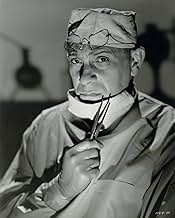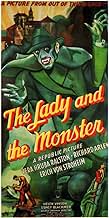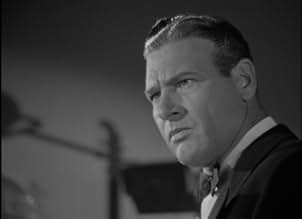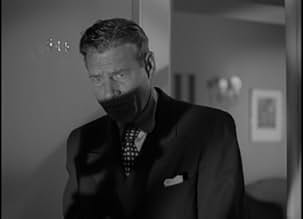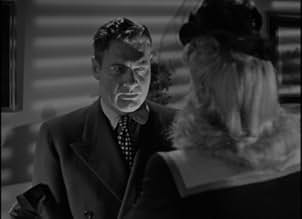Füge eine Handlung in deiner Sprache hinzuA millionaire's brain is preserved after his death, and telepathically begins to take control of those around him.A millionaire's brain is preserved after his death, and telepathically begins to take control of those around him.A millionaire's brain is preserved after his death, and telepathically begins to take control of those around him.
- Regie
- Drehbuch
- Hauptbesetzung
Vera Ralston
- Janice Farrell
- (as Vera Hruba Ralston)
William Henry
- Roger Collins
- (as Bill Henry)
Fred Aldrich
- Bus Driver
- (Nicht genannt)
Walter Bacon
- Pedestrian
- (Nicht genannt)
James Carlisle
- Nightclub Patron
- (Nicht genannt)
Lane Chandler
- Ranger White
- (Nicht genannt)
Empfohlene Bewertungen
A mad scientist called Professor Franz Mueller and his assistants keep alive the brain of a dead, crooked finance magnet called WH Donovan, who was killed in a nearby 'plane crash. However the brain has telepathic powers and takes control of scientist Patrick Cory. Mueller lives in a "castle" in the Arizona desert, the wind howls outside whilst inside his lab equipment buzzes and bubbles away, the sets are impressive and the camera work is good. Film noir, Gothic horror and science fiction. Erich von Stroheim puts in a good performance as Franz but the Lady, Janice, was played by Vera Rolston, originally from Czechoslovakia, she looks glamorous but her delivery of lines in English is quite wooden. I enjoyed this movie, despite being a bit plodding at times ,and would consider watching it again. The title is rather misleading, there is no monster as such, but that original poster artwork is very cool. This was the first filmed version of the novel "Donovan's Brain", on this basis I would like to see the others too.
1944's "The Lady and the Monster" was among the few Republic examples of the horror genre (serials and outdoor pictures were their bread and butter), unfortunately tainted by the godawful presence of Czech skating star Vera Hruba Ralston, sweetheart and later bride of studio president Herbert J. Yates, who spent 14 years spending extravagant amounts on her box office failures until the Poverty Row outfit finally collapsed at the same time as RKO. This was the first of three adaptations of the 1942 novel "Donovan's Brain," the first penned by screenwriter Curt Siodmak, so popular that he conceived a 1968 sequel called "Hauser's Memory," earning its lone adaptation as a 1970 TV movie, followed by 1991's "Gabriel's Body." The original title graced the 1953 version with Lew Ayres, while the second remake, 1962's British-German "Vengeance," was branded "The Brain" for American audiences. Yates only decided on the final moniker to signify Vera's importance to this initial screen version (no relation to George Zucco's "The Monster and the Girl"), shooting titles including "The Monster," "The Monster's Castle," "The Monster and the Lady," and "The Brute" (a later reissue earned yet another title, "The Tiger Man"). When cutting away from the intrigue to return to her attractive yet superfluous character the film only grinds to a halt, spending the entire first half on exposition before finally getting down to business. Erich von Stroheim enjoys one of his best remembered leading roles as Dr. Franz Mueller, whose isolated home outside Phoenix is an impressive castle where he conducts experiments on the brains of animals to see how long they survive when the body is deceased. Just as he and assistant Patrick Cory (Richard Arlen) pine for the use of a human specimen a nearby plane crash claims the life of renowned financier William H. Donovan, perhaps the most distinguished brain that any mab lab could want, pronounced dead by the local coroner to allow easier access to what lies inside the skull. Only at the midway point do we finally receive the novel's plot in more detail, Cory (the actual protagonist on the written page) encouraged by Mueller to continue the experiment through a telepathic link, sending the unwitting guinea pig west to Los Angeles to try to free a convicted killer from federal prison. Also taking an interest in Cory's every move are Donovan's scheming attorney (Sidney Blackmer) and faithless wife (Helen Vinson), left penniless by her husband's cleverness, multiple bank accounts set up only by an odd signature. The mystery holds up until the finale, where Cory explains all in a sadly perfunctory dialogue session, Mueller receiving his comeuppance from an unexpected source.
THE LADY AND THE MONSTER is the first version of Curt Siodmak's often filmed novel "Donovan's Brain". This first version is largely forgotten, and those that recall it usually dis-miss it as inferior to the 1953 version DONOVAN'S BRAIN with Lew Ayres. While the 1953 version is superior in almost every way, THE LADY AND THE MONSTER is still an entertaining, atmospheric 1940's thriller.
The plot is basically the same, but in this version the living brain of Donovan possesses the mind of scientist Richard Arlen to clear his illegitimate son who has been wrongly convicted of murder. The brain also wants to get revenge on his daughter, whom is just as money hungry and ruthless as Donovan was in "life." Even though Donovan's goals are good, his disembodied brain is still ruthless; he orders the possessed Arlen to kill a girl who gave false testimony at his son's trial.
We can always tell when Donovan is about to possess Arlen, the lighting and Arlen's make-up changes. The 1953 version employed no such tricks, and relied entirely on the acting skills of Lew Ayers. (See my entry on that version). Erich Von Stroheim plays the elder scientist, and as with any film he was in, he was always a commanding presence. There are hints of him having an unhealthy infatuation with Vera Ralston, but this doesn't lead anywhere.
Overall, LADY AND THE MONSTER isn't as good as the later 1953 version, but it is still a decent 1940's horror thriller.
The plot is basically the same, but in this version the living brain of Donovan possesses the mind of scientist Richard Arlen to clear his illegitimate son who has been wrongly convicted of murder. The brain also wants to get revenge on his daughter, whom is just as money hungry and ruthless as Donovan was in "life." Even though Donovan's goals are good, his disembodied brain is still ruthless; he orders the possessed Arlen to kill a girl who gave false testimony at his son's trial.
We can always tell when Donovan is about to possess Arlen, the lighting and Arlen's make-up changes. The 1953 version employed no such tricks, and relied entirely on the acting skills of Lew Ayers. (See my entry on that version). Erich Von Stroheim plays the elder scientist, and as with any film he was in, he was always a commanding presence. There are hints of him having an unhealthy infatuation with Vera Ralston, but this doesn't lead anywhere.
Overall, LADY AND THE MONSTER isn't as good as the later 1953 version, but it is still a decent 1940's horror thriller.
Although I did like my two viewings of Felix E. Feist's 1953 film version of Curt Siodmak's DONOVAN'S BRAIN (with Lew Ayres and Gene Evans), somehow I have yet to acquire it for my home video collection; besides, I am also familiar (from an age-old Italian TV screening) with the later Freddie Francis version entitled VENGEANCE aka THE BRAIN (1962) where Peter Van Eyck and Anne Heywood had the leading roles. What I did acquire very recently, however, is the even rarer original version directed by the reliable George Sherman and starring the great Erich von Stroheim, Contrary to expectations, the latter is neither the monster of the title nor (for the initiated) the man taken over by the dead financial wizard's brain; that unlucky guy is Richard Arlen – the hero of ISLAND OF LOST SOULS (1932) no less – who, as Stroheim's unlikely assistant in his underground experiments, gets to become even more obsessed with their celebrated cerebral specimen than his crazed mentor! From the rest of the cast, Vera Hruba Ralston may have later become Mrs. Herbart J. Yates (when she married the head of Republic Pictures, the studio behind this film) but, frankly, she brought very little to this particular film; on the other hand, it was nice to see Sidney Blackmer – best-known for portraying Adrian Marcato in Roman Polanski's ROSEMARY'S BABY (1968) – albeit in a supporting role of the suspicious attorney. Incidentally, the sequences depicting the blooming romance between Arlen and Ralston and those between Blackmer and Donovan's wife can mostly be written off as mere padding; small wonder, therefore, that the film was shorn of 19 whole minutes (cut down from 86 to 67!) for a later re-release
not to mention being saddled with the highly ludicrous (and utterly misleading) alternate titles of TIGER MAN and MONSTER AND TIGER MAN!! Speaking of titles, despite the sheer similarity to the earlier Paramount horror entry THE MONSTER AND THE GIRL (1941), as can be gleaned from my own reviews of both films, they have nothing whatsoever in content (other than being of the same era and genre). Despite these flaws, I generally liked the film more than I was expecting to and that fact is mostly down to two simple factors: the presence of Erich von Stroheim in front of the cameras and that of celebrated cinematographer John Alton behind them! Even though the quality of the copy I acquired was fairly fuzzy at best, Alton's atmospheric lighting came through just the same – particularly during the atmospheric laboratory sequences and the eerie scenes showing Arlen's 'possession'.
Despite the title, there is no monster, unless you count Vera Hruba Ralston's horrific attempt at acting. Beyond that, this is a pretty good B-flick, the first filming of "Donovan's Brain."
Erich Von Stroheim plays a scientist (you know where this is going already) who experiments on animal brains ... and now he is looking for a human subject. So when a plane crashes nearby, he dispatches his assistant (Richard Arlen). Arlen finds one guy barely alive and takes him back to Erich's "Castle." The guy then croaks, and we find out he was a rich dude named Donovan. Stroheim manages to remove his brain and start the ball rolling. In short order, Arlen begins to get subliminal messages from Donovan, like "if you build it, he will come."
The film gets steadily better, and Arlen does a good job transforming himself into a ruthless scumbag. The effect is heightened by what I presume was a special kind of makeup reacting to the lighting, which brought out shadows under Arlen's eyes and gave him a menacing forehead. At times, I expected him to turn into a werewolf.
Ralston is pretty much along for the ride. She looks good, but she may as well have been a mannequin that the director rolled onto the set. Von Stroheim is remarkably sedate in his role, even though he apparently sleeps with a gun.
The film's weakest aspect is the unnecessary narration.
Erich Von Stroheim plays a scientist (you know where this is going already) who experiments on animal brains ... and now he is looking for a human subject. So when a plane crashes nearby, he dispatches his assistant (Richard Arlen). Arlen finds one guy barely alive and takes him back to Erich's "Castle." The guy then croaks, and we find out he was a rich dude named Donovan. Stroheim manages to remove his brain and start the ball rolling. In short order, Arlen begins to get subliminal messages from Donovan, like "if you build it, he will come."
The film gets steadily better, and Arlen does a good job transforming himself into a ruthless scumbag. The effect is heightened by what I presume was a special kind of makeup reacting to the lighting, which brought out shadows under Arlen's eyes and gave him a menacing forehead. At times, I expected him to turn into a werewolf.
Ralston is pretty much along for the ride. She looks good, but she may as well have been a mannequin that the director rolled onto the set. Von Stroheim is remarkably sedate in his role, even though he apparently sleeps with a gun.
The film's weakest aspect is the unnecessary narration.
Wusstest du schon
- WissenswertesIn an interview, longtime Republic Pictures director Joseph Kane said that director George Sherman found working with star Vera Ralston so taxing that after this film was completed he quit Republic, where he had spent many years, because he thought he was going to be asked to direct another one of her pictures.
- PatzerWhile Janice and Patrick talk before leaving to go to the party, her black handbag falls off a chair. When they turn to leave, the bag is back on the chair.
- Zitate
Prof. Franz Mueller: What do I know about the brain itself? Nothing. Can it think? Remember after its body is dead? Could it be made to feel, to hear perhaps, or to express itself in some way? To contact the living?
- VerbindungenFeatured in Movies at Midnight: The Lady and the Monster (1954)
- SoundtracksYours (Quiereme Mucho)
Written by Augustin Rodriguez, Gonzalo Roig and Jack Sherr
Top-Auswahl
Melde dich zum Bewerten an und greife auf die Watchlist für personalisierte Empfehlungen zu.
Details
- Laufzeit1 Stunde 26 Minuten
- Farbe
- Seitenverhältnis
- 1.37 : 1
Zu dieser Seite beitragen
Bearbeitung vorschlagen oder fehlenden Inhalt hinzufügen

Oberste Lücke
By what name was The Lady and the Monster (1944) officially released in India in English?
Antwort
